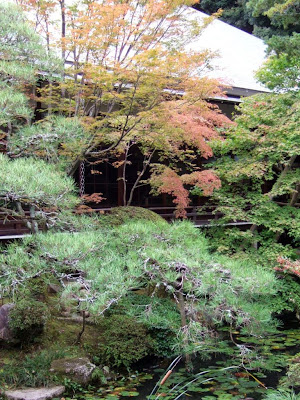
Eikan-do Temple that lies at the northern side of the large Nanzen-ji Temple complex is very famous for its fabulous fall foliage and night illumination in the season. The Temple was established by a monk named Shinsho (797-873) who was aspired to look for a temple for the five Wisdom Buddha Godio Nyorai. He purchased a mansion in year 853 but waited for 10 years before he was granted a permit from Imperial court to build it into a temple. The Temple was first named as Zenrin-ji which literally means Temple in a calm grove but after Rev. Yikan (1033-1111) became its abbot in year 1072, the temple was widely known as Eikan-do. Abbot Yokan also pronounced as Eikan, was the leading disciple of Shingon-shu sect and he emphasized on philanthropic practices. In early 13th century, when Rev. Jo'on (1201-1271) was on the seat of a chief monk. the practice of temple changed from the sect of Shingon to Pureland Jodo-shu which was introduced in year 1225 to Japan.


The most recognizable structure of Eikan-do Complex is its Tahoto Pagoda that nested on the hill side on top of all other buildings. The current two storey tower that has a round top sitting at a square base was rebuilt in 1928. Stored inside the pagoda are many cultural treasures including some main Buddhist images and paintings. Tahoto means multi-jewels Pagoda and it usually refers to the Multi-Jewels Pagoda that Buddha Sakyamuni sharing a seat with Multi-Jewels Buddha, when delivered Dharma on the teachings of Dharma Flower Sutra. I wonder whether Tahoto was also inspired from the Sutra when it was first built. I climbed up from the steep stairs just wanted to pay my sincere homage to the two seated Buddha Images usually would have enshrined side by side in a Multi-jewels pagoda. Unfortunately, the pagoda was not opened for public.


Tahoto Pagoda sitting at the highest point within the compound offers spectacular views of scenery particularly in fall season.


Main Complex of the buildings was constructed along the side at the base of the hill with a connecting wooden corridor. Before the aristocratic mansion turned into a temple, it was winded up by Karamon main gate and inner gate Yakuimon. Though Karamon was restored in 19th century and Yakuimon in 18th century, their origins still can be seen reflecting in its architectures.


Main Temple complex comprises of several buildings and they are linked to Tahoto Pagoda by a roofed wooden corridor built on a bluff. Main structures include Shakado Hall of historical Buddha, Founder Hall that honors Master Honen who found Japan Jodo-shu Pureland sect of Buddhism; and 17th century built Amida Hall that enshrines the principal worship image of Amidabha Buddha with head turning over his shoulder.



The great work of the 77cm tall unique image of the seated Amidabha Buddha in Amida Hall, was believed to be done in 12th century during Heian period (794-1185). The image of this Turning Buddha known as Mikaeri Amida is a national cultural property. Legend said that one day when the temple Abbot Yikan (1033-1111) at the age of 50, was circling the image of Amida Nyorai while chanting a sutra, the Buddha Statue became alive and the monk was so astonished that he stopped walking. Buddha Image Nyorai looked back over his shoulder and reminded him that he was slow. The figure was said to have been remained at this posture since then.


The original buildings faced the same fate as happened in many temples in Kyoto, all destroyed during Onin War (1467-1477). Most of the existing buildings were restored in early 16th century.


The written Dharma phrases were extracted from the renowned Mahayana Dharma Flower Sutra saying that One who steps into a Buddhist shrine hall and utters "Namo Fo" meaning I take refuge with Buddha, he has already planted a root for Buddha-hood.


Though Eikan-do was not a Zen Temple, a chief monk's chamber Hojo was included in the temple complex. It was built in Edo period and said to be by the order of Emperor Go-Kashiwabara (1500-1526)


The little rock garden was set at the Hall of ancient Buddha Hall Shakado which also has some beautifully Fusuma screen painting.


Little creeks squeezing and running through the temple grounds are all finally ended into Hojo pond.



Temples amidst in the lush turn into part of the scenic sight at site, particularly in fall season.







The covered corridor Garyu-ro that lead to Tahoto pagoda with steep stairs was built over a cliff.



There are too many things to explore in the temple site, its buildings, its scenery and its history. Visitors enjoyed walking through its wooden corridor, going from one hall to another.



An old brass bell hanging at roof eave.


Eikan-do Temple being a popular prominent learning center in the past, is also very famous for its fall foliage.



Looking down from Takoto Pagoda







The last flight of steps ascending to Tahoto is rather steep


The magnificent view of Kyoto city in autumn from Tahoto Pagoda.







No comments:
Post a Comment